Related Research Articles
Herpetoculture is the keeping of live reptiles and amphibians in captivity, whether as a hobby or as a commercial breeding operation. "Herps" is an informal term for both reptiles and amphibians. It is undertaken by people of all ages and from all walks of life, including career herpetologists, professional reptile or amphibian breeders, and casual hobbyists.

The Round Island day gecko, Phelsuma guentheri, also known as Günther's gecko, is an endangered species of gecko. It lives on the islet Round Island (Mauritius), and typically dwells on different palm trees. The Round Island day gecko feeds on insects and nectar.

The Mauritius lowland forest day gecko, also known commonly as the orange-spotted day gecko, is a diurnal species of gecko, a lizard in the family Gekkonidae. The species is native to the western coast of Mauritius and typically inhabits large trees. The Mauritius lowland forest day gecko feeds on insects and nectar.

Seipp's day gecko is an endangered diurnal species of lizard in the family Gekkonidae. The species is native to northern Madagascar, typically inhabits rainforests, dwells on trees, and feeds on insects and nectar.
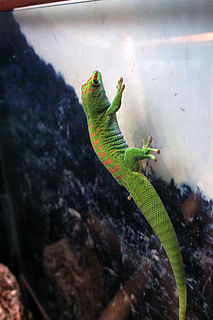
Seychelles giant day gecko is diurnal subspecies of geckos. It lives on the island Praslin in the Seychelles and typically inhabits trees and dwellings. The Seychelles giant day gecko feeds on insects and nectar.

Phelsuma pronki is a critically endangered diurnal species of gecko, a lizard in the family Gekkonidae. The species is endemic to central Madagascar, and threatened by severe habitat loss and collection for the international pet trade. It typically inhabits rainforests, dwells on trees, and feeds on insects and nectar.
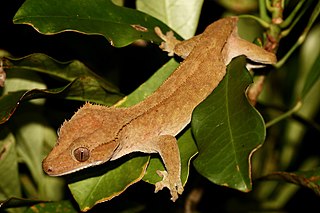
The crested gecko or eyelash gecko is a species of gecko native to southern New Caledonia. In 1866, the crested gecko was described by a French zoologist named Alphone Guichenot. This species was thought extinct until it was rediscovered in 1994 during an expedition led by Robert Seipp. Along with several other New Caledonian gecko species, it is being considered for protected status by the Convention on the International Trade in Endangered Species of Wild Flora and Fauna.

The common leopard gecko is a ground-dwelling lizard native to the rocky dry grassland and desert regions of Afghanistan, Iran, Pakistan, India, and Nepal. The common leopard gecko has become a popular pet, and due to extensive captive breeding it is sometimes referred to as the first domesticated species of lizard.
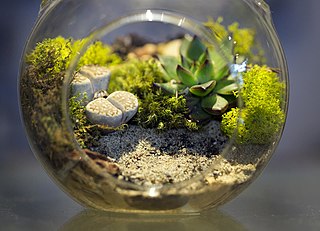
A vivarium is an area, usually enclosed, for keeping and raising animals or plants for observation or research. Often, a portion of the ecosystem for a particular species is simulated on a smaller scale, with controls for environmental conditions.

Uroplatus phantasticus, the satanic leaf-tailed gecko, eyelash leaf-tailed gecko or the phantastic leaf-tailed gecko, is a species of gecko indigenous to the island of Madagascar. First described in 1888 by George Albert Boulenger, U. phantasticus is the smallest in body of the Uroplatus geckos, though there is an ongoing debate as to whether one of its cousins, U. ebenaui, is smaller because of its shorter tail.
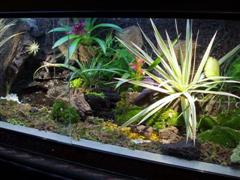
A paludarium is a type of vivarium that incorporates both terrestrial and aquatic elements. Paludaria usually consist of an enclosed container in which organisms specific to the biome being simulated are kept. They may be maintained for purely aesthetic reasons or for scientific or horticultural purposes. The word 'paludarium' comes from the Latin word 'palus' meaning marsh or swamp and '-arium' which refers to an enclosed container.
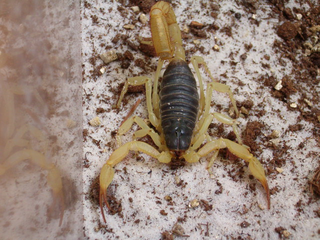
Hadrurus spadix is a large scorpion native to the southern deserts of North America. It is a burrowing scorpion which spends a lot of time digging in the sand and enlarging its burrow. A similar species is the giant desert hairy scorpion.
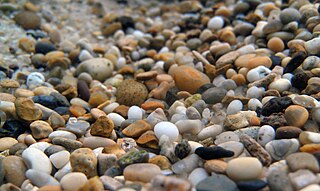
The substrate of an aquarium refers to the material used on the tank bottom. It can affect water chemistry, filtration, and the well-being of the aquarium's inhabitants, and is also an important part of the aquarium's aesthetic appeal. The appropriate substrate depends on the type of aquarium; the most important parameter is whether the aquarium contains fresh water or saltwater.

Davus fasciatus, commonly known as the Costa Rican tiger rump, is a species of a new-world tarantula native to Costa Rica. This is a terrestrial species with a maximum legspan of 12 centimetres (4.7 in), which makes it a rather small tarantula species, yet it is one of the largest of its genus.

An aquarium is a vivarium of any size having at least one transparent side in which aquatic plants or animals are kept and displayed. Fishkeepers use aquaria to keep fish, invertebrates, amphibians, aquatic reptiles, such as turtles, and aquatic plants. The term aquarium, coined by English naturalist Philip Henry Gosse, combines the Latin root aqua, meaning 'water', with the suffix -arium, meaning 'a place for relating to'.

Blaptica dubia, the Dubia roach, orange-spotted roach, Guyana spotted roach, or Argentinian wood roach, is a medium-sized species of cockroach which grows to around 40–45 mm (1.6–1.8 in).

Diplodactylus vittatus, commonly known as the eastern stone gecko, stone gecko, and wood gecko, is a species of diplodactylid lizards that occurs in forest, shrubland and arid regions across Australia. It is widespread across the states of Queensland, Victoria and New South Wales, commonly found in dry peripheral bushlands. This gecko can be kept as a pet or seen within zoo enclosures.
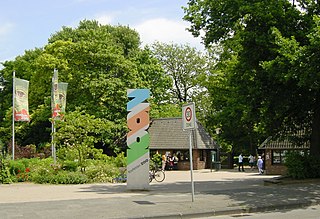
Krefeld Zoo is a zoo in the city of Krefeld, Germany, specialized in management of primates, carnivores, fauna from the African savanna and tropical birds.

Saltuarius salebrosus, also known as the rough-throated leaf-tailed gecko or Central Queensland leaf-tailed gecko, is a gecko found in Australia. It is endemic to dry areas in mid-eastern and south-central Queensland.
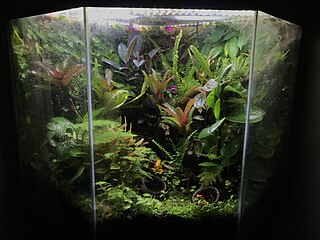
A bioactive terrarium is a terrarium for housing one or more terrestrial animals that includes live plants as well as populations of small invertebrates and microorganisms to consume and break down the waste products of the primary species. In a functional bioactive terrarium, the waste products will be broken down by these detritivores, reducing or eliminating the need for cage cleaning. Bioactive vivariums are used by zoos and hobbyists to house reptiles and amphibians in an aesthetically pleasing and enriched environment.
References
- ↑ "Setting up a Vivarium". Badmanstropicalfish.com. Retrieved 2011-10-04.
- ↑ "Different Types of Reptile Substrates and Bedding". Leopardgeckocare.net. Retrieved 2011-10-04.
- ↑ "Leopard Geckos | Leopard Gecko | Leopard Gecko Care". Leopardgeckopetcare.com. Retrieved 2011-10-04.